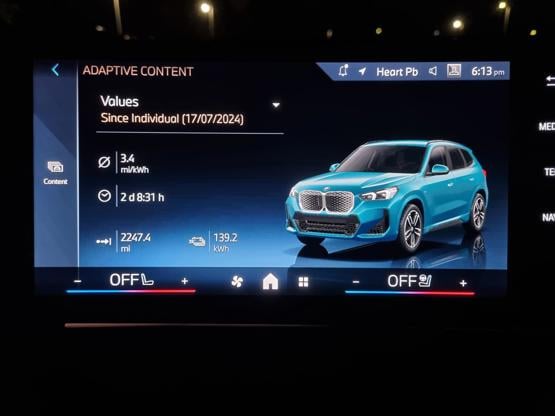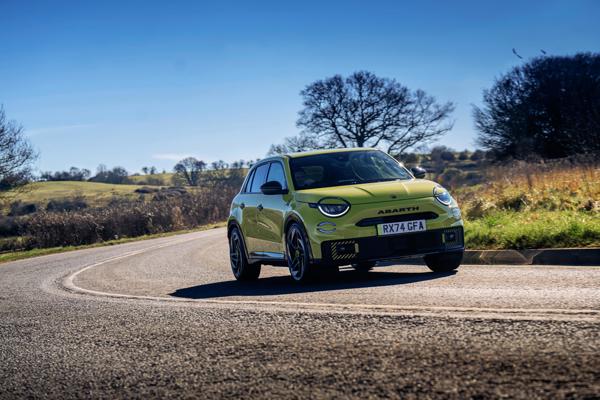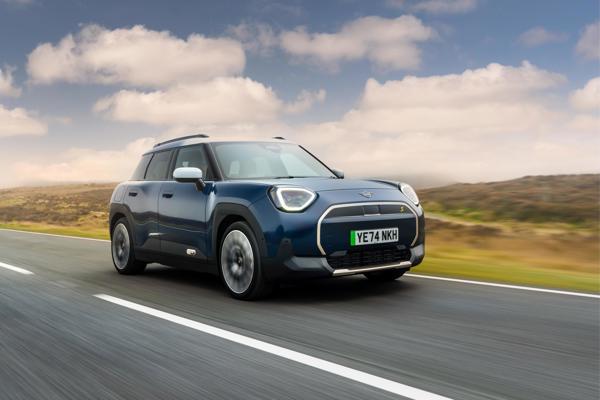Review
Ever since taking delivery of the iX1 I’ve had this small niggle in the back of my mind: is a proper BMW?
At face value, the X1 doesn’t really fit into BMW’s core speciality of making great driver’s cars. It’s a practical, safe and cost-effective family car. And on those points BMW has nailed the brief. We can’t really fault the iX1 as a compact SUV. It’s great.
Compared to a 3 Series, 5 Series or i4, however, the iX1 doesn’t feel like an ‘ultimate driving machine’. Its platform is shared with the Mini Countryman, a car which suits it better. With front-wheel drive and a modest power output, it’s only the sharp steering that delivers any dynamism.

When hopping between the iX1 and other cars, there is something about the feel of iX1 car that sets it apart. There’s a precision and weight to the controls that’s ‘just right’. It feels like BMW’s engineers have a put a little bit of extra effort into making sure everything is calibrated correctly, compared to other cars in the segment.
Yet, in the true fleet market, the iX1 is outsold by the i4 - by quite some margin. While the Audi Q4 e-tron and Mercedes EQA also attract more drivers than the iX1 does. Perhaps it’s the pricing that puts people off. While the starting price is very competitive, at around £46,000, to get a decent spec car like ours you’re looking at around £60,000.
Audi gives you more range and more power for that money, and even BMW can offer an i4 for less.
During our time with the iX1 it averaged 3.4mi/kWh, which gives a real-world range of 220 miles. It’s mediocre, at best. While the official figure is still below 300 miles, there’s plenty of cars in the iX1’s price bracket that can travel much further.

BMW regains some brownie points when it comes to technology and digital interaction. The iX1’s iDrive system is miles ahead of most others. Operation is via the central touchscreen only, as BMW decided not to equip the iX1 with a rotary iDrive controller. In practice, this hasn’t been too much of an issue. The interface has been redesigned to make it more user friendly for touchscreen use. There’s also an intelligent voice assistant that reacts to natural speech.
One of our favourite features is the MyBMW app. Not only is it super easy to set up and pair to the car, it also enables great interaction via a smartphone. You can pre-heat the cabin, manage the charging schedule, see where the car is on a map and even remotely access the on-board cameras.
Fierce competition
I keep thinking of the iX1 as a compact SUV but in truth it’s not really that small. With a length of 4.5 metres it takes up the same amount of space as a Hyundai Tucson, Kia Sportage or VW Tiguan.
The illusion of compactness is, in part, due to the iX1’s lower driving position. You sit down into the car rather than climb up and on board. From the driver’s seat it’s not much different to being in a hatchback.
From a practicality perspective I have little to complain about. There’s plenty of room on board for long-distance comfort and the boot, while smaller than that of the typical family SUVs, still has a respectable 450 litres of space. That’s the same as you get in a Volvo EC40 and more than 100 litres above the capacity offered by a Mercedes EQA.
A clear premium segment contender, the iX1 has a high-quality interior. Build quality is top-notch and there’s a decent mix of materials and quality touch points.

Competition is fierce, however. While the BMW has an edge over mainstream models when it comes to perceived quality and technology, cars like the Kia EV6 and Hyundai Ioniq 5 offer more range for less money.
If we focus on the BMW’s direct rivals, taking badge kudos into account, then the Audi Q4 e-tron, Mercedes EQA and Volvo EC40 are all probably going to be up for consideration by drivers.
The iX1 eDrive20, in M Sport trim, has the lowest P11d price compared to these, at £50,900.
Mercedes comes second with its EQA250+ AMG Line at £51,955, followed by the EC40 Plus at £52,500. The Audi Q4 45 S Line is £53,765, although it is a larger car.
Running costs for the iX1 are the cheapest, at 52ppm, once again followed by the EQA at 53ppm. The Audi and Volvo both cost 55ppm to run over a four-year (80,000 miles) cycle.
BMW also achieves the strongest residual value of the group, making it a no-brainer choice on paper.

But there are other considerations to make. At 65kWh, the iX1 has the smallest battery and is good for 240 miles of real-world range. The Audi and Mercedes can both manage around 260 miles, while the Volvo manages just 220.
From a styling perspective, the BMW looks the most modern and eye-catching. The larger Audi wins when it comes to practicality and passenger space. Performance is also strongest in the Q4, as it has a 286PS motor. The Mercedes is the slowest, offering just 190PS.
The iX1 stands out in numerous categories, then, but based on our experience so far it’s the thing that BMW supposedly does best where we feel the car falls short. The driving experience is not quite as good as we’d expected.
With front-wheel-drive the iX1 struggles for traction. Its single motor powertrain delivers only mediocre performance. While the steering is razor sharp and the throttle response is on point, compared to rear-driven EVs, like the Q4 and EX40, the iX1 doesn’t quite have the same appeal.
Opt for the twin-motor iX1 xDrive30 and the tables are turned quite significantly. That one, however, is £6,000 more expensive. If you can, then do.
Range and charging
With a few years of electric car driving under my belt, I’d like to think I’m pretty immune to range anxiety. Or at least I hoped. What I’m actually used to is not having to worry about charging because the range of whatever I’m driving is more than enough for my trip.
Since taking delivery of the iX1, I have to admit, there’s been a few occasions where charging stops have been needed that other cars wouldn’t require.
The iX1 is equipped with a 64.7kWh (useable) battery and our car’s (eDrive20 M Sport) official range is 275 miles.
During the warmer summer months my estimated range from a full charge was around 230 miles and that seemed a fair prediction based on its real-world achievement. As it has gotten colder, that estimation has slipped to 212 miles and we’re not exactly into sub-zero temperatures yet.
The Fleet News EV Range tool, using data from EV Database, predicts a real-world range of 240 miles for the iX1. Usually, my own experiences are aligned with these figures, but not in this case.
According to the car’s trip computer, I’m currently averaging 3.3mi/kWh. Down from 3.6mi/kWh in the summer.
While these figures aren’t horrendous, it does highlight that the iX1’s battery is a little on the small side to suit high mileage drives.

The Audi Q4 e-tron we also have on our long-term fleet, currently, is able to comfortably manage 300 miles on a charge, thanks to its 77kWh battery. Similarly, when I ran a BMW i4 eDrive40 – with an 80.1kWh battery - I could crack the 300-mile barrier.
Here’s a real-life example of how the iX1’s range can be a little impractical. I regularly drive to Heathrow from Peterborough, sometimes as often as once per week. In the last few years I’ve never needed to stop and charge on the journey, which is a round-trip of 192 miles.
Should be simple enough in the iX1 then? Well, I set off with 100% charge and was slightly alarmed when I arrived with a promised 51%. That’s still enough to get me home, just, but not with much of a safety margin.
More forensic analysis, using the excellent MyBMW app shows my journey actually consumed 28kWh of energy – so I should’ve been left with 57%.
After a nice holiday I returned to the iX1 to find the same 51% promised and a remaining range of 107 miles. I hit home on the sat-nav and began my journey.
After a few miles of driving the sat-nav decided a charging stop was needed and set a waypoint for South Mimms services on the M25. I was still convinced that I’d make it home but I fancied a cup of tea so I thought I’d let the car have its charge.
I plugged in and while inside a notification on my phone alerted me that – after seven minutes – the car was satisfied that it had taken on enough power. It had boosted the battery from 33% and 70 miles remaining to 52% and 107 miles. Impressive.
As I had somewhere to be the following day, I left the car going for a further nine minutes. By this time it had reached 66% and 137 miles. The iX1 doesn’t have particularly impressive charging specs, with a max rate of 128kW, but in this example it proved particularly rapid.
I’ve yet to try driving the iX1 until it actually runs out but I suspect it will keep going for quite some time after ‘zero’ as the range prediction seems particularly pessimistic. Most drivers aren’t going to be that bold, however, and the sight of just 212 miles on a cold-ish day might not cut it for some.
BMW iX1 eDrive20 M Sport joins our fleet
When BMW introduced the iX1, it had one major problem: the car was just a little bit too expensive.
That’s because when the iX1 launched it was only available in twin-motor xDrive30 guise, priced at £54,000.
A more budget-friendly option has since joined the line-up; starting at a more affordable £46,150. Known as the eDrive20, it gets by with a single 204PS motor and the same 64.7kWh battery.
BMW says this is the model that fleet customers are likely to favour, so it’s the one we’ve opted for.

Our car comes in M Sport trim – the highest of three available grades – and wears a few extra optional extras, bumping the price to £58,424. Whoops.
Chief among the pricey add-ons is the (not-strictly-necessary) M Sport Pro pack. Costing £2,400, it adds adaptive suspension, big red brake callipers, a rear spoiler, M Sport front seats, and 19-inch wheels.
We’ve also got the Tech Pack (£1,680) which adds some more useful features like keyless entry, electric folding door mirrors, adaptive LED headlights with high-beam assist and an auto-dipping rear-view mirror.
On top of the fairly generous specification that comes with all iX1 models, we’ve got a heated steering wheel (£175) and a panoramic sunroof (£1,100) too.
The result is a car that could be described as “all show and no go”. The BMW Individual ‘Blue Bay Lagoon’ paint certainly gives a striking appearance, especially when combined with the sporty M additions.
Base-model iX1s can look a little underwhelming, but that’s certainly not the case with YH73 UXM. The interior is upholstered in Alcantara and BMW’s Veganza fake leather, the bucket-style seats have built-in illuminated ‘M’ logos and all the exterior trim pieces are finished in glossy black.
As a result of the configuration, the car’s WLTP range drops from 293 miles to 275 miles.
It might seem like we’ve got everything including the kitchen sink, but no. A few option boxes have remained unticked. Much to my dismay, this almost-sixty-grand beemer has manually adjustable seats! The audacity.
Jokes aside, the iX1 is a fabulous compact SUV. We ran a plug-in hybrid X1, previously, and had lots of positive things to say. I imagine the iX1 will leave a similar impression by the time it goes back.
Specs
| Manufacturer | BMW |
| Model | IX1 Electric Estate |
| Specification | BMW IX1 Electric Estate 150kW eDrive20 M Sport 65kWh 5dr Auto [Tech/Pro] |
| Model Year | 2023.00 |
| Annual VED (Road tax) | £10 |
| BIK List Price | £51,980 |
| Range | 279.00mile(s) |
| CO2 | N/A |
| BIK Percentage | 2% |
| Insurance Group | N/A |
| CC | 1 |
| Fuel Type | Electric |
| Vehicle Type | Compact SUV |
| Luggage capacity (Seats up) | 490litres |
| Doors | 5 |
Running Costs
| P11D | £51,980 |
| Cost per mile | 63.61ppm |
| Residual value | £17,475 |
| Insurance group | N/A |
| Fuel Type | Electric |
| Cost per mile | 252.57ppm |
| Fuel | 2.37ppm |
| Depreciation | 249.60ppm |
| Service maintenance and repair | 0.60ppm |
Rivals
Info at a glance
-
P11D Price
£51,980
-
MPG
N/A (WLTP) -
CO2 Emissions
N/A -
BIK %
2% -
Running cost
3 Year 60k : £17,475 4 Year 80k : £13,925 -
Fuel Type
Electric -
Range
279.00mile(s)




































